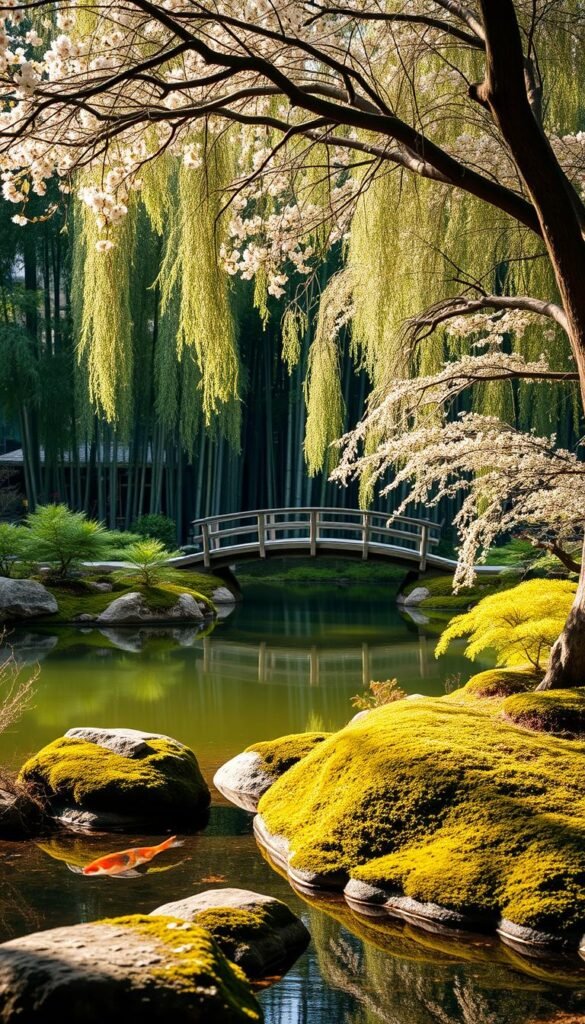Imagine stepping into your yard and feeling instant calm. For over 1,400 years, cultures have crafted outdoor spaces that balance nature and mindfulness. These areas use rocks, water features, and strategic plant arrangements to create harmony—a practice originally inspired by 7th-century spiritual traditions.
This approach goes beyond typical landscaping. Every stone placement and winding path serves a purpose, inviting you to slow down and reconnect with your surroundings. You’ll learn how to blend timeless design principles with your personal taste, whether you have acres or a cozy patio.
We’ll guide you through adapting these concepts to your climate and space. Discover how flowing water elements or raked gravel patterns can become focal points for relaxation. For more ideas on enhancing your outdoor gardening aesthetic, explore our companion guide.
By embracing these methods, you’ll create more than just a pretty yard—you’ll build a sanctuary that evolves with the seasons. The result? A living space that encourages quiet reflection while celebrating nature’s effortless beauty.
Understanding the Essence of a Japanese Garden
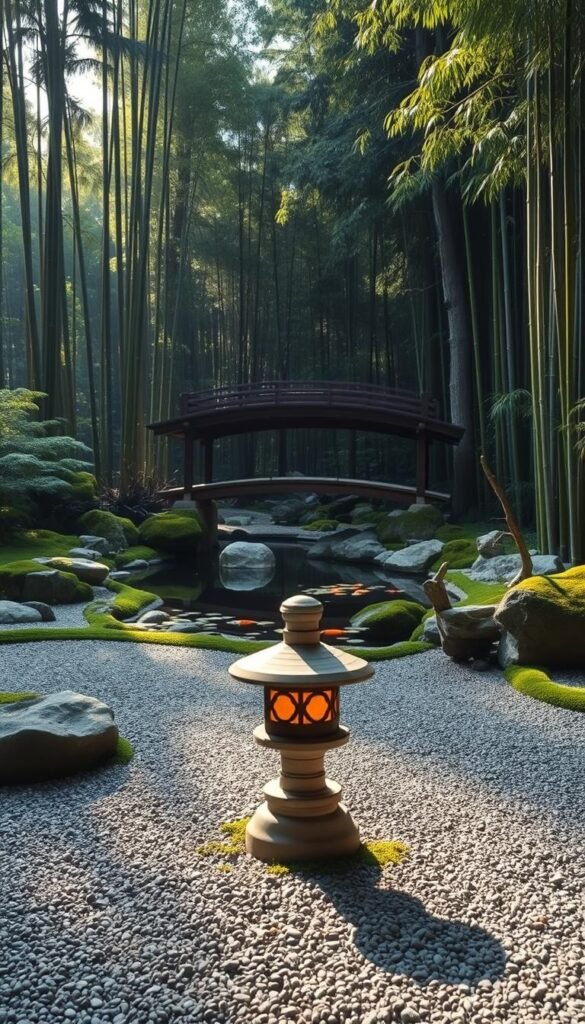
Creating a mindful outdoor retreat begins with grasping its core philosophy. Traditional designs follow seven guiding principles that shape every detail—from stone arrangements to plant selections. These rules aren’t just about looks; they’re tools for fostering inner peace through thoughtful interaction with nature.
Exploring Cultural and Philosophical Roots
At the heart of these spaces lies a blend of spiritual practices and artistic expression. Austerity and simplicity work together to strip away distractions, while asymmetry creates dynamic visual flow. Consider this table showing key concepts:
| Principle | Meaning | Design Example |
|---|---|---|
| Kanso (Simplicity) | Removing clutter | Single maple tree as focal point |
| Fukinsei (Asymmetry) | Balancing uneven elements | Offset rock grouping |
| Yūgen (Mystery) | Suggesting depth | Curved path disappearing behind shrubs |
The Role of Minimalism and Harmony
Less doesn’t mean empty—it means intentional. A carefully placed boulder might symbolize a mountain, while raked gravel mimics ocean waves. This approach creates harmony between hardscapes and soft greenery, inviting you to pause and reflect.
Water features often serve dual purposes. A small basin isn’t just decorative—it’s a meditation tool, with its sounds masking urban noise. By blending these elements, your space becomes a bridge between daily life and nature’s timeless rhythms.
Planning Your Backyard Transformation
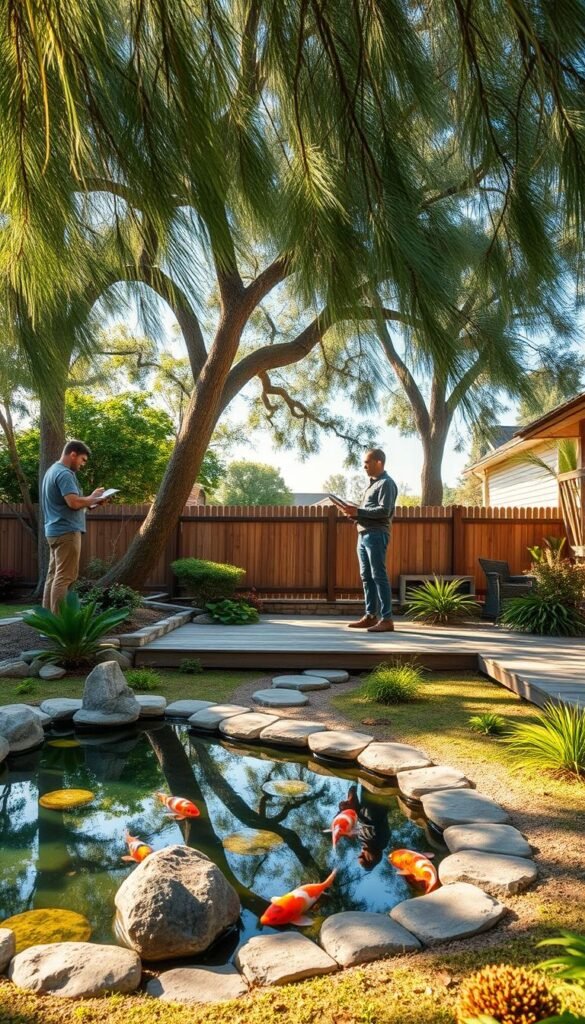
Turning an ordinary yard into a peaceful retreat requires thoughtful preparation. Start by identifying quiet corners where natural light filters through trees or where existing structures offer privacy. These spots often become ideal foundations for creating intentional areas of calm.
Assessing Your Outdoor Space
Grab a tape measure and sketchpad. Map your yard’s dimensions, noting slopes, sunlight patterns, and existing plants. Flat space works best for meditation zones, while shaded sections suit moss gardens. Consider drainage—areas pooling water after rain might need grading adjustments.
Visit local botanical gardens or browse Japanese garden ideas online for layout inspiration. Notice how paths curve gently or how rocks anchor compositions. Jot down features that resonate with your vision.
Defining Your Vision and Budget
Decide which elements matter most. A stone lantern? Bamboo fencing? Use this table to prioritize:
| Feature | Priority | Cost Range |
|---|---|---|
| Gravel pathways | Essential | $100-$300 |
| Water basin | High | $200-$600 |
| Professional design help | Optional | $500+ |
Allocate funds for durable materials like granite or weather-resistant wood. For budget-friendly accents, explore repurposing vintage items as planters or decor. Phase projects if needed—install foundational elements first, add decorative touches later.
This planning stage saves time and ensures every choice aligns with your goal: crafting a personal sanctuary that grows more inviting each season.
Japanese Garden Backyard Makeover: Adding Serenity with Eastern Style
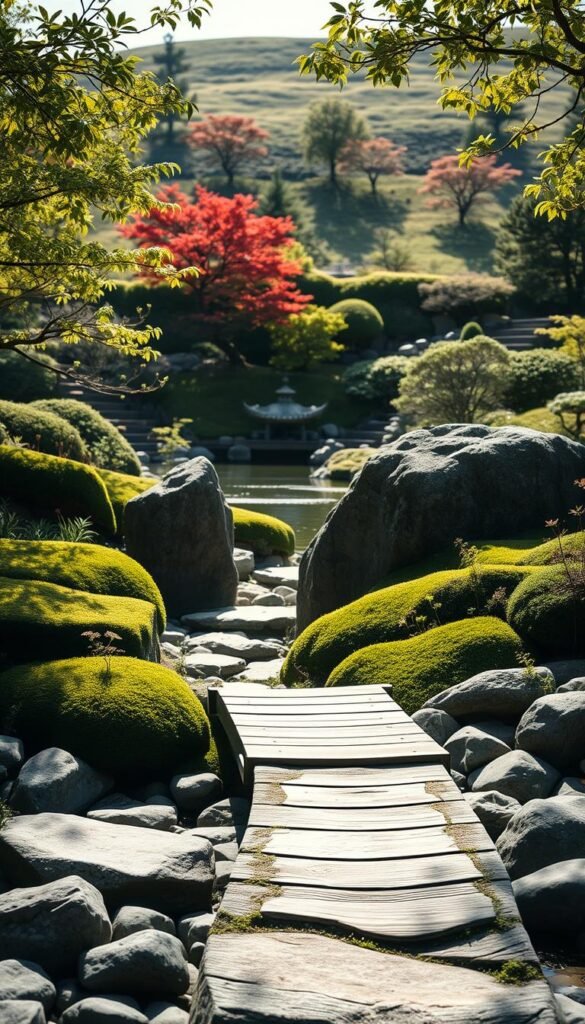
True peace in your outdoor area comes from more than just adding a few plants and stones. Crafting an authentic space requires balancing design elements like flowing water and textured gravel to evoke harmony. Every choice—from the curve of a pathway to the placement of a lantern—should feel intentional yet effortless.
Key features like koi ponds or bamboo screens do more than beautify—they create rhythm. A wooden bridge becomes a visual anchor, while stone basins reflect sunlight like natural mirrors. These pieces work together to form a living composition that changes with the seasons.
Gravel isn’t just filler—it’s a canvas. Raked patterns mimic waves or wind, adding movement without clutter. Pair it with mossy stepping stones to guide visitors through the space slowly, encouraging mindful exploration.
Worried about overcrowding? Start with three core elements: one water feature, one structural accent (like a lantern), and one textured ground cover. Build outward gradually, letting empty spaces breathe. This approach keeps your design focused and calming.
Up next, you’ll learn how to shape specific zones for meditation or tea ceremonies. These practical ideas will help you maximize every corner of your yard while maintaining that essential sense of balance.
Designing Zen and Tea Garden Areas
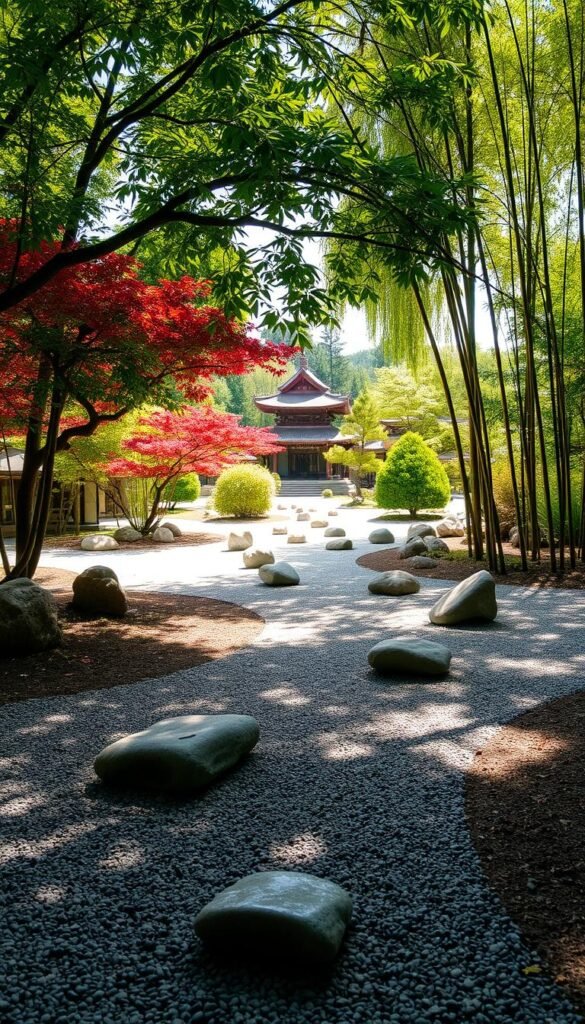
Transform your outdoor area into a peaceful retreat by mastering two iconic elements. Dry landscapes and ceremonial spaces each offer unique ways to connect with nature’s rhythms through intentional design.
Incorporating Meditative Elements
Zen gardens thrive on simplicity. Start with a base of fine gravel or sand—this becomes your canvas. Use a wooden rake to create flowing patterns that mimic water currents. Place three to five weathered stones asymmetrically, imagining them as mountain peaks rising from an ocean.
Keep plants minimal. A single moss-covered rock or dwarf shrub adds texture without clutter. This space becomes your open-air meditation zone, where raking becomes a mindful practice. No water features needed—the gravel’s texture and patterns tell the story.
Creating an Intimate Tea Ceremony Space
Tea gardens prepare visitors for quiet rituals. Design a winding path using irregular stepping stones. Line it with low stone lanterns that cast soft shadows at dusk. Let moss creep between pavers to soften edges and muffle footsteps.
Your tea area needs privacy. Use bamboo screens or tall ferns to frame a small platform or pavilion. Include a stone basin for ritual handwashing—its gentle splash sets the tone. Keep the journey to this space deliberate, encouraging guests to shed distractions before arriving.
Both zones can coexist beautifully. Place your zen area where morning light highlights raked patterns, and position the tea corner in dappled shade. Together, they create layered experiences rooted in traditional Japanese principles of purposeful design.
Utilizing Natural Elements and Authentic Materials
The foundation of a tranquil space lies in its connection to raw, unaltered resources. Every texture and shape should feel intentional, blending function with symbolic meaning. Let’s explore how to source and arrange natural elements that age gracefully while maintaining their purpose.
Selecting Stones, Bamboo, and Wood
Start with rocks that tell a story. Look for irregular shapes with weathered surfaces—granite or slate work well. Place larger stones as focal points, smaller ones along pathways. Bamboo adds vertical interest while softening hard edges. Use thicker poles for fencing, slender stalks for decorative screens.
When choosing wood, opt for rot-resistant varieties like cedar or redwood. Leave surfaces untreated to develop a silvery patina over time. These materials work together to create layers of texture that feel rooted in nature.
Integrating Water Features and Gravel Paths
Water features bring movement and sound. A shallow basin with a bamboo spout offers simplicity, while a recirculating stream adds dynamic energy. Position them where sunlight dances on the surface for added sparkle.
For pathways, choose gravel that crunches underfoot yet holds patterns when raked. Finely crushed varieties create smooth canvases, while pea gravel offers a softer look. Light-colored stones reflect moonlight, extending your garden’s magic into evening hours.
Pair these elements with personalized garden art for subtle creative touches. Remember: each choice should enhance the whole without competing for attention. Your space becomes a conversation between earth’s raw beauty and thoughtful human touch.
Emphasizing Simplicity and Balance in Layout
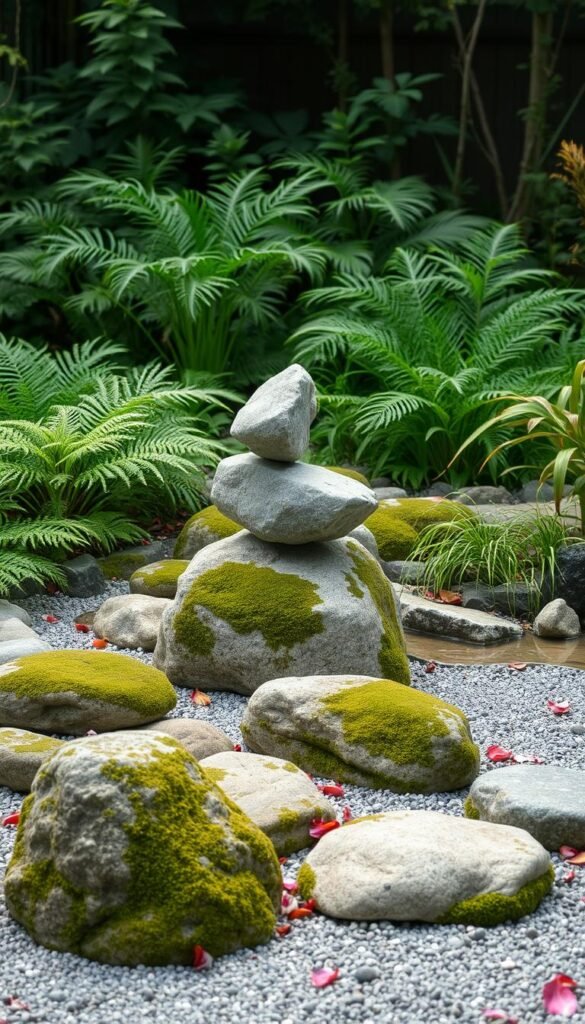
Crafting a balanced outdoor space starts with purposeful choices. The magic lies in pairing contrasting textures and letting empty areas breathe. Think of your layout as a visual poem—every mark matters, but silence between words gives them power.
Strategic Stone and Moss Pairing
Traditional three-stone groupings create instant focus. The tallest rock anchors the scene, symbolizing celestial energy. A medium stone represents human connection, while the smallest bridges both worlds. This triad forms the backbone of your design.
| Stone Size | Symbolism | Placement Tip |
|---|---|---|
| Tallest | Heaven | Position northwest for morning shadows |
| Medium | Humanity | Angle toward seating areas |
| Smallest | Bridge | Place near water or pathways |
Moss softens stone edges, creating harmony between hard and soft elements. Cluster it around base rocks or let it spill over aged lanterns. This living carpet adds depth without clutter, especially in shaded spots.
Avoid scattering stones randomly. Instead, create triangular patterns that guide the eye naturally. Leave ample space between groups—crowding breaks the calming rhythm. Remember: restraint lets each piece shine.
Test layouts by sitting where you’ll view them most. Adjust angles until the arrangement feels effortless. When done right, your space becomes a meditation on balance, where every element earns its place through intention.
Creative Design Ideas for Diverse Outdoor Spaces
What if your cozy corner could become a peaceful retreat? Compact areas demand smart solutions that honor tradition while maximizing impact. Let’s explore how to craft intimate gardens that feel spacious through clever garden design choices.
Adapting Principles to Compact Areas
Vertical elements transform cramped courtyards. Train ivy along walls or hang bamboo planters to draw eyes upward. Use narrow stone paths to guide movement, flanked by low moss borders. These ideas create depth without eating into precious square footage.
Multi-functional features work wonders. A bench doubling as storage hides gardening tools, while a shallow basin serves as both water feature and bird bath. Stick to three materials max—weathered wood, smooth pebbles, and aged bronze—to maintain visual calm.
Strategic lighting extends your area’s magic after sunset. Place solar lanterns behind foliage to cast leaf patterns on walls. For tighter spaces, a single maple tree in a corner becomes a living sculpture that shifts with seasons.
Remember: balance thrives in simplicity. Let empty zones breathe between features, and watch your petite landscape radiate quiet confidence. Ready to turn that overlooked nook into your personal oasis?

